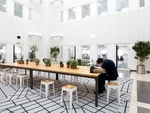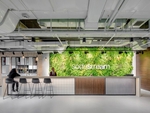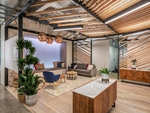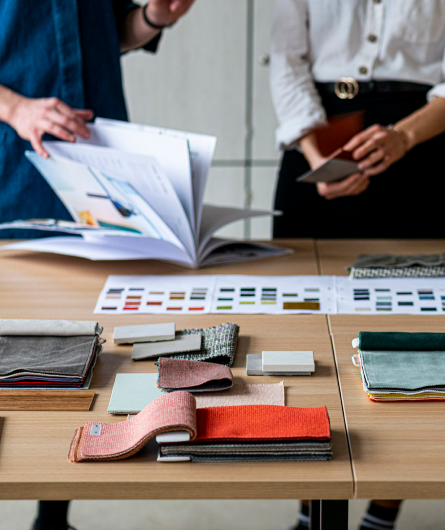
Workplace Trends Accelerated by COVID-19
How the coronavirus has directly affected workplace trends and how these apply in the post-pandemic scene. Some trends we see accelerated, whilst others are challenged.
The coronavirus is the most radical life interruption that the majority of generations in this day and age have ever experienced. As we have all retired to the protective shell of our homes, the workplace has been left deserted. However, people and their place will be gradually reconciled as collectively, we learn to manage and control the risks of viral transmission and care for and protect one another. A profound, multifaceted change will be seen in the workplace and how this will look is a question many are trying to answer. In a recent webinar, we focused on forecasted workplace trends from the past couple of years and analysed how these will apply in the post-pandemic scene. Based on insights from industry-leading experts and extensive market research, we segmented these trends into two categories: those we see accelerating and those that may be challenged in the next era of the workplace.
Accelerated Trends
These are the trends we see rising in importance in the post-COVID workplace.


User Experience
The concept of this trend is about moving towards a more human-centric workplace. As human beings, we have a need for experiences. People need to be fully engaged, feel a connection to the company’s identity, and a sense of belonging to the brand community. We believe this is one of the most important trends we will see accelerating as we move into the initial phases of return to the physical workplace. As companies embrace an increase in distributed work, people will be physically present for fewer hours, so the workspace needs to deliver a more intense, more memorable, more impactful experience, which overcomes health and safety related anxiety, and fosters community and human connection. In a recent blog we explored the idea of whether employees will consider the workplace as a second safe haven away from home. The experience needs to instill confidence in every space user that they are returning to a healthy, safe environment; one that exudes protection and is fully supportive of newfound working styles. External factors beyond the workplace itself will also need to be considered as part of managing the entire return experience, for example, the commute will be an integral part of the new working day, and if this involves the combination of the health risks of public transport, tightened security levels including health screening and elevator queues, this presents a much longer, more stressful journey to work, and will likely discourage people from stepping out of their home environment. The new experience will become a blend of three environments: homeworking, virtual collaboration and the physical workplace. We will become heavily reliant on seamlessly functioning technology as we aim to integrate the virtual environment with the physical, giving each user an inclusive and equal experience, regardless of their location.

Perpetual Beta
Perpetual Beta is about an approach of continual learning and experimentation, resulting in continuous improvement, forming the optimal working environment for everyone. Through a natural evolution, modular ‘architecture within architecture’ creates a workplace in which furniture can be easily reconfigured and adapted to suit users better. This will be a hugely important design approach to adopt as we move into the short-term phase of the return. With a vast amount of rapid innovation and development of physical barriers that give a sense of safety, the workplace landscape is going to undergo a considerable transformation, and whilst this may mitigate the fears of personal safety being at risk, the workforce needs time to adapt and feel comfortable in the space. Flexibility and resilience are going to be essential in shaping the success of the post-COVID environment; the workplace will be one huge experiment. Taking an innovative and open-minded approach to space will allow the workspace to naturally evolve and respond to changing needs, forming the optimal user-friendly, human-centric future state.

Tech Fusion
Silicon Valley giants have long been leading the way in high-tech workspaces, embracing new disruptive technologies in an integrated manner to build the user experience. For example, Internet of Things connecting workplace facilities and absorbing vast amounts of data from which intelligent design and operational choices can be made. As a blended distributed work model becomes the norm, there will be a need for a seamless integration of the virtual environment into the physical. Off-site employees cannot have a degraded experience, and this will be heavily reliant on flawlessly functioning virtual collaboration platforms. As an unprecedented, unknown experience, workplace strategists will also become reliant on enhanced data collection to make intelligent, informed decisions. For example, companies will be focusing on reducing density in the light of maintaining social distancing, so will be reliant on occupancy data and analysis for specific locations throughout the office. As the workplace evolves into its reimagined state, a deeper commitment to wellbeing may see the introduction of touchless technologies to guard against viral transmission. For example, avoiding the use of common touchpoints like elevator buttons, light switches and handrails, through the use of gesture control, facial recognition and voice activation.

Human Connection
In recent years, human connection has become a valued luxury. Society is suffering from a loneliness epidemic, largely driven by technology. Technology was supposed to connect us, but in some ways has driven us further apart, and this collective experience of virtual collaboration has proven the sense that there is no virtual substitute for authentic face-to-face interaction. We see this desire for human connection becoming more prominent as undoubtedly, isolation has only exacerbated the loneliness epidemic, with reported increased levels of loneliness, anxiety and depression. Everyone is missing one another, and as Gensler discovered in their recently published ‘Work From Home Survey’, a large majority of people say that ‘the people’ is what they miss most about the office. Data suggests this will become the primary reason for people returning to the workplace: to experience an enriching human connection and feel once again connected to brand community and company culture. However, current circumstances may drive this form of connection to become more intentional. Health and safety concerns with physical distancing mean there will be lower levels of occupancy, and therefore less people to connect with, so we see a reduction in spontaneous or chance interaction. As Andy Swann, an expert in complex relationships between people, said on a recent panel discussion with Spacstor “great ideas comes from perspectives overlapping, if you don’t have those opportunities just to have a casual conversation where something might be sparked, that’s quite a big risk.” So this reduction in spontaneous connection could have a negative effect. However with careful management, staggering the return of people and ensuring there is a diverse representation of the workforce in the office each day, will facilitate cross functional teaming and spark impromptu collaboration between different people.

Building Communities
The idea of building communities is a development of human connection. It’s human connection that forms the foundation of community building. Human connection is more from the employees’ point of view, whereas building communities if from the employers’ perspective. Up until lockdown, people have been striving to design authentic spaces in which people feel a sense of belonging and a connection to the company’s mission and the physical representation of its brand. Once these communities have grown, knowledge transfer and collaboration become an organic process within them, leading to great innovation and elevated competitive advantage. We feel this trend will become ever more important in the post-pandemic scene. As Adrienne, global director of workplace strategy at Merck, said in a recent panel discussion with Spacestor, “the real attraction to coming to the office is going to be community.” However, curating community needs to be balanced with the health and safety aspect of social distancing, which will require an innovative design approach to formulate the best structure to support this. Moving into the post-pandemic we need to appreciate, more than ever before, the value and importance of the workplace forming the tangible nucleus of a company’s identity, the foundational platform to create the communal experience that’s unique to the brand. As Philippe Paré, managing director of Gensler France, said in a recent panel with Spacestor, “you have to look at it from the perspective of the workplace being really important for you to do all those things that aren’t done so easily from home, and I think it will reaffirm the importance of the workplace when it comes to collaboration, building social capital, and using the workplace as the physical manifestation of a company's brand.”

Health & Wellbeing
Employee health and wellbeing has gradually become a strong focus as part of the workplace experience, however as we return, it will rise to become the highest priority. It’s become a life or death matter. Creating an aura of safety and hygiene in the workplace needs to come as an immediate reaction to COVID-19; employees’ expectation of personal safety cannot be disregarded. A key goal for employers will be to instill confidence and trust in their people that they are providing them with a healthy and safe environment. Even building the perception of safety through physical barriers like sneeze guards and taller workstation dividers, visual cues and wayfinding graphics, will give people the reassurance they need and guide them safely throughout the workplace. Then there’s the psychological aspect of wellbeing. Employers need to be mindful of the levels of anxiety and shock people have endured in recent months. As Adrienne Rowe said in a recent panel discussion, this shared experience that applies to us all has engendered “a feeling of empathy which will help our collective wellbeing in mental health.” To maintain elevated standards of hygiene that viral control demands, a communal effort will be required. Renewed cleaning and hygiene protocols will be introduced, and there will likely be an increased responsibility of sanitation per individual. As part of the immediate return, we see this becoming a minimum expected behaviour and a sign of respect shown for surrounding colleagues.
Challenged Trends
Here are some of the trends that we see being less likely to accelerate. We feel nothing has truly gone away, however we do believe that some trends will be challenged, by the current workplace situation.


Sustainability
Climate change is a huge issue facing the world, and we are all finding more sustainable ways of living and working to a greater or lesser extent. Whilst we see this as a fundamental issue becoming ever more important in the long-term, we believe that for the short-term, amidst all the panic-stricken reactions to COVID-19, this has become less of a focus in the minds of workplace strategy. We have seen some of these more sustainable requirements rested as companies strive to get employees back to work as economically as possible. We see the prevalence of plastic sneeze screens, which, as a temporary installment, is not rated an environmentally-friendly choice as acrylic has poor recyclability. Copper is also being considered for its antimicrobial properties, however copper takes a lot of energy and resources to mine. As well as materials, the use of space will have an impact on sustainability. With reduced density, the footprint and associated energy costs per person will increase. Also, as many will continue working from home for a higher proportion of their working week, the efficiencies associated with multi-occupied offices are lost. However, this may of course be offset by the reduction in travel. The immediate focus for property owners and developers is to get people back to work safely. However sustainability and well-being needs to be considered too. Some companies are choosing their return to work solutions carefully and are working harder to achieve this, however in some cases sustainability goals are being challenged for the short term.

Hospitality Trend
Over the past few years, we have seen emerging synergies between interior design in the hospitality sector and the workplace. A blending of elements of hotel lobbies, cafes and restaurants with the workspace has introduced a softer, more luxurious look to interiors. With the design phase of the immediate return, there will be a greater focus on surfaces with optimal cleanability in respect of employee health and safety. We feel this could result in a move towards a harder, colder aesthetic, sacrificing the warmth and luxury created by a hospitality-inspired interior. However, we only see this trend potentially numbed in the short term under the influence of the current climate. As we grow to understand the behaviour of this virus and get a greater control over it, we will have greater intelligence as to meaningful transmitters of the virus. No one wants their workspace to look like a hospital, so we see companies actively working against this risk to avoid a knock-on effect on user experience. As Steve Collins, associate director at TP Bennett, said in a recent panel discussion with Spacestor, “if in the future you’re coming into the office to collaborate and meet people, then the hospitality environment is more important than ever.”

Coworking
Up until the crisis of COVID-19, we were witnessing an expansion into coworking spaces; these spaces were no longer considered for freelancers and startups only. We were beginning to see, more and more, the coworking model being applied to corporate real estate, with many beginning to adopt this new ‘flex space’ style of working. In the post-pandemic scene, we’re hearing about the importance of ‘untethered’ working, or the ability to work anywhere. For those who have had a poor work-from-home experience, access to a coworking space will mean you can still work near your home, avoiding the safety risks posed by public transport amidst the commute. However the biggest challenge to overcome will be whether these types of space users trust it’s a safe space. It’s more likely you would place a higher level of trust in your coworker (to stay away if they have symptoms) rather than somebody who is not part of your company culture. The test will be whether coworking space providers can overcome these challenges and fears to reassure users of their space.

Amenity-rich Spaces
This trend has been largely inspired by the success of coworking spaces and Silicon Valley tech giants providing a far wider and more enticing spread of amenities than the average office. A bounty of exceptional amenities and perks help companies to differentiate from rivals in the attraction of talent and contributes to boosting the user experience. These predominantly social spaces will pose a challenge to maintain social distancing, as well as reducing physical contact with high-traffic touchpoints with the ‘sharing’ characteristic of such spaces. For these reasons, recreational spaces and amenities are likely to be kept closed for the immediate return to work with employee safety and infection control taking priority. Examples include shared canteens, gyms, restaurants, yoga rooms and bars. Each of these spaces rely on shared equipment and are highly sociable so physical distancing would be easily broken down, which the employer would feel responsible for. However, as we move into the reimagined future of the workplace, and we become better at managing the risks we face and our knowledge and understanding grows, we may see strategies being developed to safely reopen these spaces.
We are constantly analysing these trends as we gain further insights from clients and observe the movements and choices of different organisations. The current climate will no doubt present unexpected and unforeseen challenges as we experience the immediate return phase, so we’ll be examining the workplace response closely. And then when we break through to a vaccination, the post-vaccine scene may look entirely different again.
Take a look at the Insights Live Webinar below!







Global media company Condé Nast have recently refurbished their headquarters in the 1 World Trade Center in New York. A…
SPORTS, MEDIA & ENTERTAINMENT

Vital Proteins' new space in Fulton Market has been designed to accommodate a growing workforce, connecting the wellnes…
SCIENCES

IA Interior Architects recently completed a confidential software company's office design in San Ramon, California. The…
TECHNOLOGY & IT
